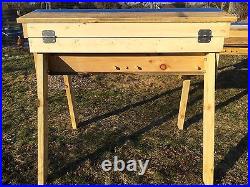
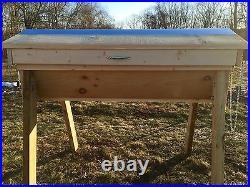

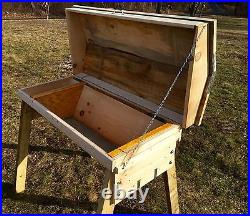
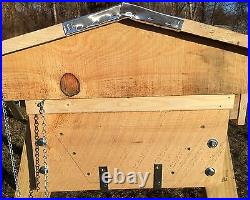
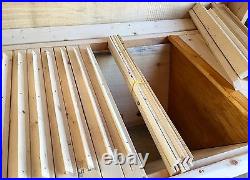
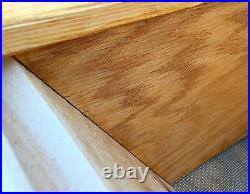
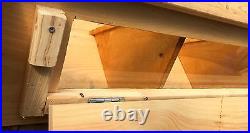
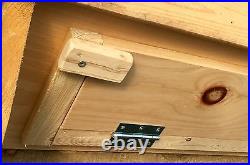

Order a locally made hive from our farm! Better pricing may be available through our site. This will give you an idea of where all the pieces go. It also gives you an idea of some of the labor involved. This is now an option for buyers in the lower 48 States only. You can pick it up at our farm or we can deliver it to your door if you live in CT, RI, or MA. The hive is made with 1 thick locally sourced rough cut pine. This is thicker and provides more insulation than conventional boards. It’s rustic rough cut surface can be painted, stained or protected with oils as you see fit. Bolting on the legs is the only assembly required. Please check out our site for customization options. It’s easier to select add ons and check out through our site. We can talk you through customization options and help you pick what’s right for you. The pressure treated legs are at a sturdy angle and are bolted to the frame. The hinged roof has 2 of head space for tool storage and/or winter insulation. The hinges have removable pins in case you want to take the roof off completely. The roof is chained so it doesn’t over extend as you inspect the hive. 2 follower boards made from high grade oak plywood. 30 19 top bars with comb guides. 10 1/4 spacers. Solid bottom board included. Screened bottoms are available upon request. There are five entrance holes on the hinge side of the hive (three in the middle and one at either end of the sides). Other entrance options are available. YOU’LL SEE YOU CAN CUSTOMIZE YOUR HIVE WITH OR WITHOUT AN OBSERVATION WINDOW, AND CHANGING IT’S ENTRANCES FOR YOUR NEEDS. Insulation: Adding 2 insulation will likely mean that the roof cannot be used to store tools, since the cavity will be filled with insulation. 1 insulation will still provide room for some tool storage above the bars. Observation Window: This can be build into the hive and provide you and your family with a safe and unintrusive way of seeing what your ladies are up to. I use glass instead of plexi and I seal it by using animal safe caulking. This way neither the glass nor the caulking off-gasses into your bees’ home and into their stores. Entrances: You can choose the standard 5 entrance layout where the hive starts building comb in the center of the hive and works toward the ends. You may choose a slot entrance in the end wall of the hive where the hive starts on one end and works toward the other. BEFORE YOU CHECK OUT, LOOK AT THE OTHER PRODUCTS THAT ARE MADE FOR THIS HIVE’S DIMENSIONS. Spare Top Bars, Spacers and Follower Board. Comb stand – to rest a bar on to take pics/inspect the comb hands free. This is also the Same width as the bars so it can rest on top of them or even inside the hive. Set of 5 entrance reducers. Eco-floor – attaches to your hive and can be used in an effort to conserve energy in the hive and possibly help the hive combat veroa mites. Feeding Frame Top Bar – a top bar framed out to hold winter candy, fondant, protein patties, etc. It is framed to fit this hive and allow bee space for the bees to move around the feeder board. Top bar bait hives/Nuc box – 10 bar box designed to hang in a tree to capture free swarms of bees and transfer them with ease into your top bar hive. This can double as a nuc box. For local pick it up: I can walk you over to the other hives that are put together and answer any questions you may have about its design. Here’s a look at some other aspects of the hive’s design. ? I’ve done a lot of research on the different top bar designs, talking to other beekeepers, and looking at other widely distributed designs by Phil Chandler, Less Crowell and the Gold Star hive. After analyzing all of these and doing some algebra, geometry, and trigonometry; I’ve settled on a design that uses a very long 19 topbar and a deep body made out of 1×12 local rough cut lumber. This means the walls are a full inch thick and provides more insulation; this is thicker than most homemade and commercial hives/kits using plywood or. Lets talk math: When I compare the cross section of my design, compared to the others available, my design seems to maximize both the volume per bar and the amount of surface area of connection per bar for bees to build their comb. This balances the need for volume and reduces the likelihood of comb breaking off. It is also based on the 60 degree and 120 degree angles the bees naturally use in comb construction. The walls are angled at 30/60 degrees to reduce the likelihood of the bees to connect comb to the walls. The 19 bars can be transferred into a traditional Langstroth hive. Meaning your healthy hive could be used to support other local beekeepers with bars of brood, honey, etc. Also, you can market nucs to both local top bar keepers as well as those who use a traditional Langstroth hive. The hive packs down to roughly a 4’x2’x2′ long box that fits in almost any car (with the seat down).

